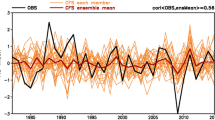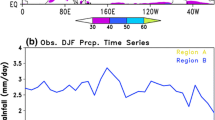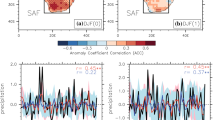Abstract
Differences between two types of prediction skill estimates over Southern Africa are illustrated to better inform the users of seasonal precipitation forecasts over the region who desire assessments of forecast accuracy. Both seasonal precipitation prediction skill estimates for the African continent south of 15°S during the December–March rainy season are derived from the perfect-model method. The perfect-model method is based on a 40-member ensemble of Community Atmosphere Model version 5 simulations forced by observed time-evolving boundary conditions during 1920–2016. The first skill estimate is based on the verification of an ensemble mean forecast spanning many seasons and therefore unconditional on a single boundary forcing. The second skill estimate is based on the verification of an ensemble mean forecast for a single season and is therefore conditional on that year’s boundary forcing. Unconditional prediction skill calculated in 30-year increments for each of the 40 possible forecasts reveals: (1) large spread in skill among the individual forecasts for any given year and (2) temporal variations in skill for each forecast. The magnitude of conditional prediction skill varies greatly from 1 year to the next, revealing that the boundary conditions offer little prediction skill during some years and comparably large skill during others. The simultaneous behaviors of the El Niño–Southern Oscillation and the subtropical Indian Ocean Dipole are related to the largest conditional precipitation prediction skill years. Unconditional skill estimates may therefore mislead users of forecasts who desire assessments of forecast accuracy. Unconditional skill may be temporally unstable, and unlike conditional skill, is not representative of the skill for a given season.




The schematic is adapted from Kumar (2007)








Similar content being viewed by others
Explore related subjects
Discover the latest articles and news from researchers in related subjects, suggested using machine learning.References
Beraki AF, Landman WA, DeWitt D, Olivier C (2016) Global dynamical forecasting system conditioned to robust initial and boundary forcings: seasonal context. Int J Climatol 36:4455–4474
Capotondi A et al (2014) Understanding ENSO diversity. Bull Am Meteorol Soc 96:921–938
Conway D et al (2015) Climate and southern Africa’s water–energy–food nexus. Nat Clim Change 5:837
Dieppois B, Pohl B, Rouault M, New M, Lawler D, Keenlyside N (2016) Interannual to interdecadal variability of winter and summer southern African rainfall, and their teleconnections. J Geophys Res Atmos 121:6215–6239
Dixon J, Gulliver A, Gibbon D (2001) Farming systems and poverty: improving farmers’ livelihoods in a changing world. FAO and World Bank, Rome, p 407
Funk C et al (2018) Examining the role of unusually warm Indo-Pacific sea-surface temperatures in recent African droughts. Q J R Meteorol Soc 144:360–383
Goddard L, Dilley M (2005) El Niño: catastrophe or opportunity. J Clim 18:651–665
Graham RJ et al (2011) Long-range forecasting and the global framework for climate services. Clim Res 47:47–55
Hansen J, Mason S, Sun L, Tall A (2011) Review of seasonal climate forecasting for agriculture in Sub-Saharan Africa. Exp Agric 47:205–240
Harris I, Jones PD, Osborn TJ, Lister DH (2014) Updated high-resolution grids of monthly climatic observations—the CRU TS3.10 Dataset. Int J Climatol 34:623–642
Hartmann HC, Pagano TC, Sorooshian S, Bales R (2002) Confidence builders. Bull Am Meteorol Soc 83:683–698
Hastenrath S, Greischar L, van Heerden J (1995) Prediction of the summer rainfall over South Africa. J Clim 8:1511–1518
Hoell A, Cheng L (2018) Austral summer Southern Africa precipitation extremes forced by the El Niño–Southern oscillation and the subtropical Indian Ocean dipole. Clim Dyn 50:3219–3236. https://doi.org/10.1007/s00382-017-3801-z
Hoell A, Funk C, Magadzire T, Zinke J, Husak G (2015) El Niño–Southern Oscillation diversity and Southern Africa teleconnections during Austral summer. Clim Dyn 45:1583–1599
Hoell A, Funk C, Zinke J, Harrison L (2017) Modulation of the Southern Africa precipitation response to the El Niño Southern Oscillation by the subtropical Indian Ocean Dipole. Clim Dyn 48:2529–2540. https://doi.org/10.1007/s00382-016-3220-6
Hurrell JW, Hack JJ, Shea D, Caron JM, Rosinski J (2008) A new sea surface temperature and sea ice boundary dataset for the Community Atmosphere Model. J Clim 21:5145–5153. https://doi.org/10.1175/2008JCLI2292.1
Jury MR (2002) Economic Impacts of climate variability in South Africa and development of resource prediction models. J Appl Meteorol 41:46–55
Jury MR, Mc Queen C, Levey K (1994) SOI and QBO signals in the African region. Theor Appl Climatol 50:103–115
Kirtman BP et al (2014) The North American multimodel ensemble: phase-1 seasonal-to-interannual prediction; phase-2 toward developing intraseasonal prediction. Bull Am Meteorol Soc 95:585–601
Kumar A (2007) On the interpretation and utility of skill information for seasonal climate predictions. Mon Weather Rev 135:1974–1984
Kumar A (2009) Finite samples and uncertainty estimates for skill measures for seasonal prediction. Mon Weather Rev 137:2622–2631
Kumar A, Chen M (2016) What is the variability in US west coast winter precipitation during strong El Niño events? Clim Dyn 49:2789. https://doi.org/10.1007/s00382-016-3485-9
Kumar A, Hoerling MP (2000) Analysis of a conceptual model of seasonal climate variability and implications for seasonal prediction. Bull Am Meteorol Soc 81:255–264
Lamarque JF et al (2012) CAM-chem: description and evaluation of interactive atmospheric chemistry in the Community Earth System Model. Geosci Model Dev 5:369–411
Landman WA, Beraki A (2010) Multi-model forecast skill for mid-summer rainfall over southern Africa. Int J Climatol 32:303–314
Landman WA, Goddard L (2002) Statistical recalibration of GCM forecasts over Southern Africa using model output statistics. J Clim 15:2038–2055
Landman WA, Barnston AG, Vogel C, Savy J (2019) Use of El Niño–Southern Oscillation related seasonal precipitation predictability in developing regions for potential societal benefit. Int J Climatol. https://doi.org/10.1002/joc.6157
Lawal KA, Stone DA, Aina T, Rye C, Abiodun BJ (2015) Trends in the potential spread of seasonal climate simulations over South Africa. Int J Climatol 35:2193–2209
Lindesay JA (1988) South African rainfall, the Southern Oscillation and a Southern Hemisphere semi-annual cycle. J Climatol 8:17–30
Manatsa D, Mushore T, Lenouo A (2015) Improved predictability of droughts over southern Africa using the standardized precipitation evapotranspiration index and ENSO. Theor Appl Climatol 127:259. https://doi.org/10.1007/s00704-015-1632-6
Mason SJ, Jury MR (1997) Climatic variability and change over southern Africa: a reflection on underlying processes. Prog Phys Geogr 21:23–50
Meinshausen M et al (2011) The RCP greenhouse gas concentrations and their extensions from 1765 to 2300. Clim Change 109:213–241
Min Y-M, Kryjov VN, Park C-K (2009) A probabilistic multimodel ensemble approach to seasonal prediction. Weather Forecast 24:812–828
Misra V (2003) The influence of Pacific SST variability on the precipitation over Southern Africa. J Clim 16:2408–2418
Neale R et al (2012) Description of the NCAR Community Atmosphere Model (CAM 5.0). NCAR Tech. Note NCAR/TN-486+STR, National Center for Atmospheric Research, p 289. http://www.cesm.ucar.edu/models/cesm1.0/cam/docs/description/cam5_desc.pdf
Nicholson S, Entekhabi D (1986) The quasi-periodic behavior of rainfall variability in Africa and its relationship to the southern oscillation. Arch Meteorol Geophys Bioclimatol A 34:311–348
Nicholson SE, Kim J (1997) The relationship of the El Niño–Southern Oscillation to African rainfall. Int J Climatol 17:117–135
Palmer TN, Anderson DLT (1994) The prospects for seasonal forecasting—a review paper. Q J R Meteorol Soc 120:755–793
Pomposi C, Funk C, Shukla S, Harrison L, Magadzire T (2018) Distinguishing southern Africa precipitation response by strength of El Niño events and implications for decision-making. Environ Res Lett 13:074015
Ratnam JV, Behera SK, Masumoto Y, Yamagata T (2014) Remote effects of El Niño and Modoki events on the Austral summer precipitation of Southern Africa. J Clim 27:3802–3815
Rayner NA, Parker DE, Horton EB, Folland CK, Alexander LV, Rowell DP, Kent EC, Kaplan A (2003) Global analyses of sea surface temperature, sea ice, and night marine air temperature since the late nineteenth century. J Geophys Res 108(D14):4407. https://doi.org/10.1029/2002JD002670
Reason CJC (2001) Subtropical Indian Ocean SST dipole events and southern African rainfall. Geophys Res Lett 28:2225–2227
Reason CJC, Rouault M (2002) ENSO-like decadal variability and South African rainfall. Geophys Res Lett 29:16-11–16-14
Reason CJC, Allan RJ, Lindesay JA, Ansell TJ (2000) ENSO and climatic signals across the Indian Ocean Basin in the global context: part I, interannual composite patterns. Int J Climatol 20:1285–1327
Reynolds RW, Smith TM, Liu C, Chelton DB, Casey KS, Schlax MG (2007) Daily high-resolution-blended analyses for sea surface temperature. J Clim 20:5473–5496. https://doi.org/10.1175/2007JCLI1824.1
Rocha A, Simmonds IAN (1997) Interannual variability of south-eastern African summer rainfall. Part 1: relationships with air–sea interaction processes. Int J Climatol 17:235–265
Ropelewski CF, Halpert MS (1987) Global and regional scale precipitation patterns associated with the El Niño/Southern Oscillation. Mon Weather Rev 115:1606–1626
Ropelewski CF, Halpert MS (1989) Precipitation patterns associated with the high index phase of the Southern Oscillation. J Clim 2:268–284
Sardeshmukh PD, Compo GP, Penland C (2000) Changes of probability associated with El Niño. J Clim 13:4268–4286
Sarewitz D, Pielke RA Jr, Byerly R Jr (2000) Prediction: science, decision making, and the future of nature. Island Press, Covelo, p 405
Schneider U, Becker A, Finger P, Meyer-Christoffer A, Ziese M, Rudolf B (2014) GPCC’s new land surface precipitation climatology based on quality-controlled in situ data and its role in quantifying the global water cycle. Theor Appl Climatol 115:15–40
Sheffield J et al (2014) A drought monitoring and forecasting system for sub-Sahara African water resources and food security. Bull Am Meteorol Soc 95:861–882
Tanre D, Geleyn J-F, Slingo JM (1984) First results of the introduction of an advanced aerosol-radiation interaction in the ECMWF low resolution global model. In: Gerber HE, Deepak A (eds) Aerosols and their climatic effects. Deepak Publishing, Hampton, VA, USA, pp 133–177
Thiaw WM, Barnston AG, Kumar V (1999) Predictions of African rainfall on the seasonal timescale. J. Geophys. Res. Atmos. 104:31589–31597
Washington R, Preston A (2006) Extreme wet years over southern Africa: role of Indian Ocean sea surface temperatures. J Geophys Res 111:D15104. https://doi.org/10.1029/2005JD006724
Weisheimer A, Palmer TN (2014) On the reliability of seasonal climate forecasts. J R Soc Interface 11:20131162. https://doi.org/10.1098/rsif.2013.1162
Wyrtki K (1975) El Niño—the dynamic response of the equatorial Pacific ocean to atmospheric forcing. J Phys Oceanogr 5:572–584
Yuan C, Tozuka T, Landman WA, Yamagata T (2014) Dynamical seasonal prediction of Southern African summer precipitation. Clim Dyn 42:3357–3374
Zhang Q, Holmgren K, Sundqvist H (2015) Decadal rainfall dipole oscillation over Southern Africa modulated by variation of Austral summer land–sea contrast along the East Coast of Africa. J Atmos Sci 72:1827–1836
Acknowledgements
The authors are grateful for support from the Famine Early Warning Systems Network and constructive comments from Tom Hamill and two reviewers.
Author information
Authors and Affiliations
Corresponding author
Additional information
Publisher's Note
Springer Nature remains neutral with regard to jurisdictional claims in published maps and institutional affiliations.
Rights and permissions
About this article
Cite this article
Hoell, A., Eischeid, J. On the interpretation of seasonal Southern Africa precipitation prediction skill estimates during Austral summer. Clim Dyn 53, 6769–6783 (2019). https://doi.org/10.1007/s00382-019-04960-5
Received:
Accepted:
Published:
Issue Date:
DOI: https://doi.org/10.1007/s00382-019-04960-5




